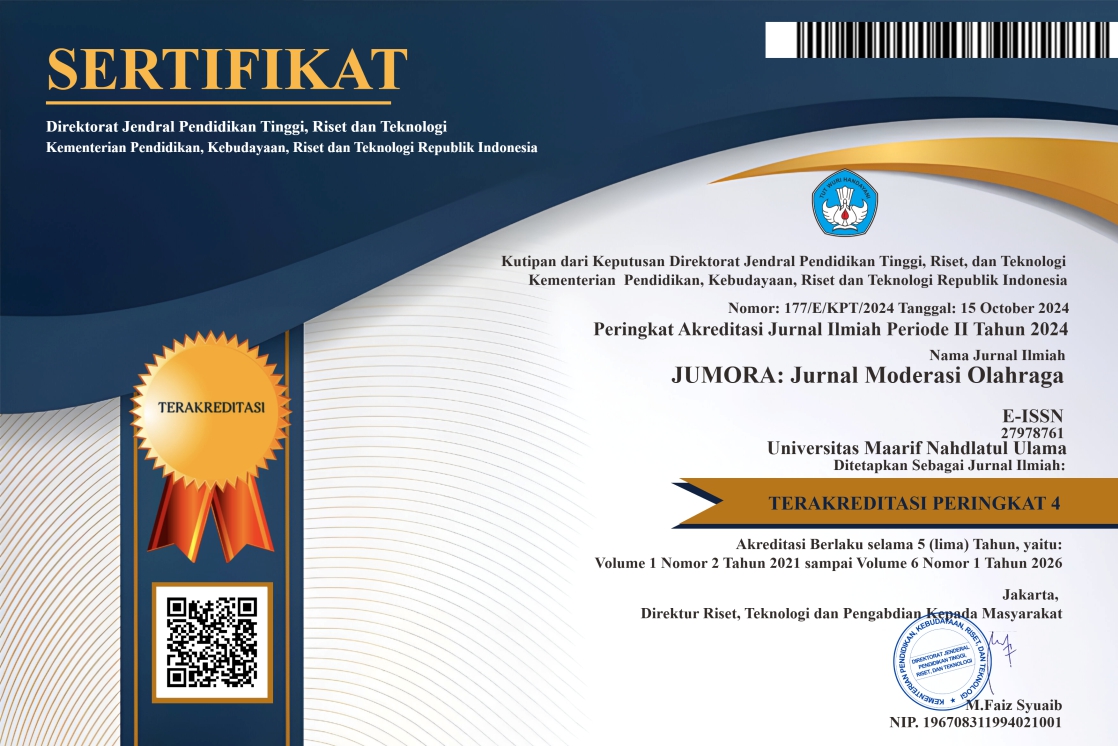Influence of Small-Sided Games and Motor Ability in Performance Games Development
DOI:
https://doi.org/10.53863/mor.v3i1.538Keywords:
Games Performance, Small-Sided Games, Motor Ability, Volleyball Information SystemAbstract
The purpose of this study is to be able to determine whether there is an influence of small sided games and motor ability on athlete performance in volleyball games. The method in this study is an experimental method where the design of this study uses factorial design. The results of this study show that small-sided games training methods, block system programs and random system programs have a significant effect on games performance, small-sided games training has interactions with motor ability that have different effects on games. While the small-sided games training method block system and random system programs have a significant effect on games performance in the high motor ability group, small-sided games training methods, block system programs and random system programs, do not have a significant effect on games performance in the low motor ability group. So that in providing volleyball training programs, especially the random system program, it should be given to athletes who have high motor ability. But for low motor ability can be used both programs, both block system programs and random system programs.
Keywords: Performance Games, Small-Sided Games, Motor Ability, Volleyball Information System
References
A Schmidth, R., & D.Lee, T. (2014). Motor Learning and Performance Fifth Edition.
Adef, D. M., Abd, E. S., Cef, A. K., & Ad, J. C. (2017). Relationships between motor abilities and volleyball performance skills in 15-year-old talent-identified volleyball players, 9(1), 17–27.
Araújo, D. (2013). The study of decision-making behavior in sport, 2011–2014. https://doi.org/10.5232/ricyde2013.031
Balyi, I., & Hamilton, A. (2004). Long-Term Athlete Development: Trainability in Childhood and Adolescence. Windows of Opportunity. Optimal Trainability.
Barnett, L. M., Ridgers, N. D., & Salmon, J. (2015). Associations between young children’s perceived and actual ball skill competence and physical activity. Journal of Science and Medicine in Sport, 18(2), 167–171. https://doi.org/10.1016/j.jsams.2014.03.001
Creswell, J. W. (2012). Educational research: Planning, conducting, and evaluating quantitative and qualitative research. Educational Research (Vol. 4). https://doi.org/10.1017/CBO9781107415324.004
Davids, K., Arau, D., & Correia, V. (2013). How Small-Sided and Conditioned Games Enhance Acquisition of Movement and Decision-Making Skills.
Donoghue, O. (n.d.). Data Analysis in Sport.
Dopsaj, M., Neši, G., & Nemanja, ?. (2010). THE MULTICENTROID POSITION OF THE ANTHROPOMORPHOLOGICAL PROFILE OF FEMALE VOLLEYBALL PLAYERS AT DIFFERENT COMPETITIVE LEVELS, 8(1), 47–57.
Filipcic, A. (2014). THE RELATIONSHIP OF TENNIS-SPECIFIC MOTOR ABILITIES AND THE COMPETITION EFFICIENCY OF, (January 2005).
Fraenkel, J. R., Wallen, N. E., & Hyun, H. H. (2013). How to Design and Evaluate Research in Education. Climate Change 2013 - The Physical Science Basis (Vol. 53). https://doi.org/10.1017/CBO9781107415324.004
Goldfarb, A. H. (2012). Exercise Physiology?: Human Bioenergetics and its Application, (January 2015), 215–216. https://doi.org/10.1080/00336297.1985.10483837
Greco, P., & Memmert, D. (2010). The effect of deliberate play on tactical performance in basketball, (June). https://doi.org/10.2466/PMS.110.3.ISSN
Grgantov, Z., & Jurko, D. (2006). technique quality and performance Motor Structures in Female Volleyball Players Aged 14 – 17 According to Technique Quality and Performance, (April).
Hewitt, J. E. (2013). Research Quarterly . American Association for Health , Physical Education and Recreation Hewitt ’ s Tennis Achievement Test, (February 2015), 37–41. https://doi.org/10.1080/10671188.1966.10613366
Igor, A., Medeiros, A., Marcelino, R., & Isabel, M. (2014). Systematic review on sports performance in beach volleyball from match analysis, (November). https://doi.org/10.5007/1980-0037.2014v16n6p698
Johann, V. E., Stenger, K., Kersten, S., & Karbach, J. (2016). Effects of motor-cognitive coordination training and cardiovascular training on motor coordination and cognitive functions. Psychology of Sport and Exercise, 24, 118–127. https://doi.org/10.1016/j.psychsport.2016.01.008
Joseph, J., Jr, H., Reed, J. P., Chiang, C., & Stone, M. H. (2013a). r Fo Pe er Re vi, (May). https://doi.org/10.1123/IJSPP.2013-0189
Joseph, J., Jr, H., Reed, J. P., Chiang, C., & Stone, M. H. (2013b). r Fo Pe er Re vi, (June 2014). https://doi.org/10.1123/IJSPP.2013-0189
Kim, T. K. (2017). Understanding one-way anova using conceptual figures. Korean Journal of Anesthesiology, 70(1), 22–26. https://doi.org/10.4097/kjae.2017.70.1.22
Kugler, A., Reininger, S., Trouillier, H., & Rosemeyer, B. (1996). MAuscular imbalance and shoulder pain in volleyball attackers, 256–259.
Lumsden, R. (2015). 36-2°,0.
Magill, R. A., & Anderson, D. I. (n.d.). E LE V E NT H E DIT ION MOTOR LEARNING AND CONTROL.
Mcgarry, T., Donoghue, P. O., Sampaio, J., Araújo, D., Davids, K., & Passos, P. (2019). Routledge Handbook of Sports Performance Analysis THE INTENDING – PERCEIVING – ACTING CYCLE IN SPORTS, (May). https://doi.org/10.4324/9780203806913.ch3
Nevill, A. M., & Hughes, M. (2008). Twenty-five years of sport performance research in the Journal of Sports Sciences, (June 2016). https://doi.org/10.1080/02640410701714589
No Title. (n.d.).
Pekas, D., Ma?ak, D., & Kosti, A. (2019). Small-sided games are more effective than instructional training for improving vertical jump performance and passing in young volleyball players, 11, 13–21. https://doi.org/10.31382/eqol.190602
Riteria 2005. (2005), 1–25.
Services, C. S. (2006). C HANGES IN S KILL AND P HYSICAL F ITNESS V OLLEYBALL P LAYERS, 20(1), 29–35.
Sheppard, J. M., Gabbett, T. J., & Riggs, M. P. (2015). Indoor and Beach Volleyball Players, (July).
Sheppard, J. M., Gabbett, T., Solutions, G. P., Claudio, L., Stanganelli, R., Londrina, U. E. De, & Newton, R. U. (2010). An Analysis Of Playing Positions In Elite International Mens’ Volleyball: Considerations For Competition Demands And Physiological Characteristics, (December 2014). https://doi.org/10.1097/01.JSC.0000367211.02914.93
Sporis, G. (2016). SKILL AND GAME-BASED TRAINING AS AN INTEGRAL PART OF VOLLEYBALL, (November).
Sporis, G. (2017). SMALL-SIDED GAMES VS . INSTRUCTIONAL TRAINING FOR IMPROVING SKILL ACCURACY IN YOUNG FEMALE VOLLEYBALL PLAYERS, (August).
Utesch, T., Bardid, F., Strauss, B., & Tietjens, M. (2015). Using Rasch measurement to investigate the construct of motor competence in preschool children Measuring Issues in Motor Assessments, (August 2016).
Utesch, T., Dreiskämper, D., Strauss, B., & Naul, R. (n.d.). The development of the physical fitness construct across childhood.
Utesch, T., Strauß, B., Tietjens, M., Büsch, D., Ghanbari, M., Seidel, I., … Münster, W. W. (2016). Die Überprüfung der Konstrukt validität des Deutschen Motorik- Tests 6-18 für 9- bis 10-Jährige, (July 2015). https://doi.org/10.1026/1612-5010/a000143
Yan, Z., & Bond, T. G. (n.d.). Measurement in Physical Education and Exercise Science Developing a Rasch Measurement Physical Fitness Scale for Hong Kong Primary School-Aged Students Developing a Rasch Measurement Physical Fitness Scale for Hong Kong Primary School-Aged Students, (December 2014), 37–41. https://doi.org/10.1080/1091367X.2011.590772
Zetou, E., & Tsigilis, N. (2006). Playing characteristics of men ’ s Olympic Volleyball teams in complex II, 10(June). https://doi.org/10.1080/24748668.2006.11868365
Downloads
Published
How to Cite
Issue
Section
License
Copyright (c) 2023 Aditya Pahlevi,Ali Munir

This work is licensed under a Creative Commons Attribution-ShareAlike 4.0 International License.
Authors retain copyright and grant the journal right of first publication with the work simultaneously licensed under a Creative Commons Attribution-ShareAlike 4.0 International License that allows others to share the work with an acknowledgment of the work’s authorship and initial publication in this journal











